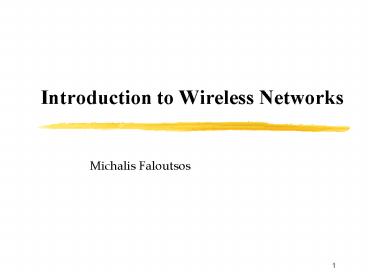Introduction to Wireless Networks - PowerPoint PPT Presentation
Title:
Introduction to Wireless Networks
Description:
wireless hosts. access point (AP): base station. BSS's combined to form distribution ... No specialized routers, no DNS servers. Nodes can be static or mobile ... – PowerPoint PPT presentation
Number of Views:37
Avg rating:3.0/5.0
Title: Introduction to Wireless Networks
1
Introduction to Wireless Networks
- Michalis Faloutsos
2
IEEE 802.11 Wireless LAN - 1
- Wireless LANs untethered (often mobile)
networking - IEEE 802.11 standard
- MAC protocol
- unlicensed frequency spectrum 900Mhz, 2.4Ghz
3
IEEE 802.11 Wireless LAN - 2
- Basic Service Set (BSS) (a.k.a. cell) contains
- wireless hosts
- access point (AP) base station
- BSSs combined to form distribution system (DS)
4
IEEE 802.11 used for Ad Hoc Networks
- Ad hoc network IEEE 802.11 stations can
dynamically form network without AP - Applications
- laptop meeting in conference room, car
- interconnection of personal devices
- battlefield
- IETF MANET (Mobile Ad hoc Networks) working
group
5
IEEE 802.11 MAC Protocol CSMA/CA
- 802.11 CSMA sender
- - if sense channel idle for DIFS sec.
- then transmit entire frame (no collision
detection) - -if sense channel busy then binary backoff
- 802.11 CSMA receiver
- if received OK
- return ACK after SIFS
6
IEEE 802.11 MAC Protocol
- 802.11 CSMA Protocol others
- NAV Network Allocation Vector
- 802.11 frame has transmission time field
- others (hearing data) defer access for NAV time
units
7
Ad Hoc Networks
8
What is an ad hoc network
- A collection of nodes that can communicate with
each other without the use of existing
infrastructure - Each node is a sender, a receiver, and a relay
- There are no special nodes (in principal)
- No specialized routers, no DNS servers
- Nodes can be static or mobile
- Can be thought of us peer-to-peer communication
9
Example Ad hoc network
- Nodes have power range
- Communication happens between nodes within range
10
What Is Different Here?
- Broadcasts of nodes can overlap -gt collision
- How do we handle this?
- A MAC layer protocol could be the answer
- If one node broadcasts, neighbors keeps quite
- Thus, nearby nodes compete for air time
- This is called contention
11
Contention in ad hoc networks
- A major difference with wireline networks
- Air-time is the critical resource
- Fact 1 connections that cross vertically
interfere - Fact 2 connections that do not share nodes
interfere - Fact 3 a single connection with itself
interferes!
12
Example of contention
- Yellow connection bothers pink connection
- Yellow bothers itself
- When A-E is active
- E-F is silent
- F-G is silent (is it?)
F
E
G
H
13
The Hidden Terminal Effect
- hidden terminals A, C cannot hear each other
- obstacles, signal attenuation
- collisions at B
- goal avoid collisions at B
- CSMA/CA CSMA with Collision Avoidance
14
Collision Avoidance RTS-CTS exchange - 1
- CSMA/CA explicit channel reservation
- sender send short RTS request to send
- receiver reply with short CTS clear to send
- CTS reserves channel for sender, notifying
(possibly hidden) stations - Avoid hidden station collisions
15
Collision Avoidance RTS-CTS exchange - 2
- RTS and CTS short
- collisions less likely, of shorter duration
- end result similar to collision detection
- IEEE 802.11 allows
- CSMA
- CSMA/CA reservations
- polling from AP
16
The 802.11 MAC protocol
RTS
RTS
A
B
D
CTS
C
CTS
- Introduced to reduce collisions
- Sender sends Request To Send (RTS) ask
permission - Case A Receiver gives permission Clear To Send
(CTS) - Sender sends Data
- Receiver sends ACK, if received correctly
- Case B Receiver does not respond
- Sender waits, times out, exponential back-off,
and tries again
17
Why is this necessary?
- A RTS, and B replies with a CTS
- C hears RTS and avoids sending anything
- C could have been near B (not shown here)
- D hears CTS so it does not send anything to B
18
Some numbers for 802.11
- Typical radius of power-range 250m
- Interference range 500m
- At 500m one can not hear, but they are bothered!
- RTS packet 40 bytes
- CTS and ACK 39 bytes
- MAC header is 47 bytes
19
Typical Simulation Environment
- A 2-dimensional rectangle
- Fixed number of nodes
- Static uniformly distributed
- Dynamic way-point model
- Pick location, move with speed v, pause
- Power range fixed or variable
- Sender-receivers uniformly distributed
20
Various Communication Paradigms
- Broadcasting
- one nodes reaches everybody
- Multicasting
- One node reaches some nodes
- Anycasting
- One node reaches a subset of some target nodes
(one) - Application Layer protocols and overlays
- Applications like peer-to-peer































